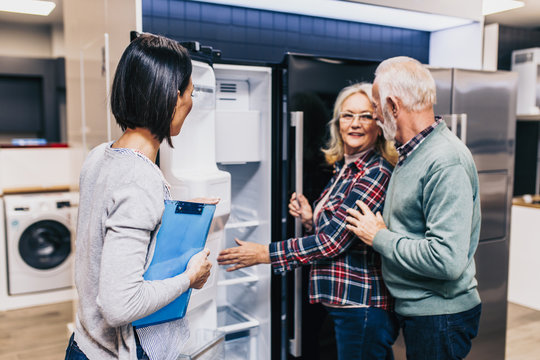There are several types of refrigerators, including side-by-side, upright, and bottom-freezer varieties. Listed below are the Inventors of Refrigerators and their contributions to our society. Inventors include people like Thomas Edison, Charles Duvall, and Benjamin Franklin. While refrigerators in other countries may be a bit more expensive, American refrigerators are among the largest and most popular. This article will discuss the components of a refrigerator, including the compressor, drawers, and trays.

Refrigerating Food
When it comes to cleanliness, refrigerators for food can be a real nightmare. The air inside can be filled with harmful pollutants, and there’s no way to know if your fridge has been contaminated by microbial pathogens. Fortunately, refrigeration technology is improving. The following are some of the things to look out for in your refrigerator. Read on for more information. The bottom line is that you should keep your refrigerator clean to ensure that your food stays fresh.
The interior of your refrigerator can harbor harmful bacteria. E. coli, for example, is one of the most common bacteria. It can cause food poisoning. Although this organism is present naturally on human skin, it can cross-contaminate foods if you have dirty hands. The same bacteria can contaminate the interior of your fridge if you touch perishable items. In addition, if your refrigerator has an unclean exterior, it could be easily colonized by insects.
A fridge can control humidity levels. Humidity is a result of water vapor in the air. When inside your fridge, water vapor condenses into tiny droplets. These water droplets can contain fungi and bacteria, which can spoil your food. Keeping food cold will help keep it fresh for longer.
Simple physics dictates the best place to store foods. The top shelves of a refrigerator will have slightly warmer air than the middle, while the coldest air will be near the bottom.
Inventors
The history of refrigerators dates back to the 1830s. Inventor Oliver Evans first developed the design for a refrigerator in 1805. He spent the next decade building a steam-powered river dredge, but his refrigerator design did not go to waste. The two men eventually collaborated on the design of a refrigerator. It wasn’t until 1834, however, that the first refrigerator was created.
Oliver Evans is credited with creating the first refrigeration machine in 1842, using liquefied ammonia instead of liquid. However, despite his efforts, Evans never built his refrigerator. Another inventor of the refrigerator was Dr. John Gorrie, a British physician who immigrated to Australia. He developed a mechanical ice-making machine in 1854 and patented it in 1855. His original design used alcohol and ether to create ice, but later models used methyl chloride and sulfur dioxide. Many early refrigerators were also used in breweries and other industries.
Iceboxes were the first fridges. Ice was collected from frozen lakes and shipped around the world, and the ice was sold to icebox manufacturers, retailers, and agents. At the time, they were very expensive, often hand-carved oak cabinets. Inventors of refrigerators were concerned about the safety of their invention, and many claimed that refrigeration poisoned food. This debate has since been settled.
Compressors
Refrigerators use compressors to cool their interiors. Like a pump, these devices draw in and pressurize the liquid refrigerant. They also have coils called evaporators and condensers, which work together to cool the interior of the refrigerator. If you want to learn more about these devices, read on. Here’s an overview of these important appliances. Listed below are a few of the benefits of using compressors in refrigerators.
In recent years, China has become one of the top three global refrigerator manufacturers. The company also focuses on developing and manufacturing refrigerator compressors. To date, it has four compressor production bases, an asset scale of more than 10 billion yuan, and more than eight thousand employees. It has consistently ranked first in the same industry for many years and has been growing its operations and management scale every year. This expansion is part of a larger strategy to make the compressors for refrigerators greener.
When purchasing a refrigeration compressor, you must consider its cooling capacity and the type of refrigerant it can handle. Different compressors have different operating ranges, so be sure to understand which one is best for your needs. While the power range of various compressors is similar, the range of operation is not. Some models are suitable for a single refrigerator, while others are better suited for several. Economical considerations should also be considered when choosing a compressor. For example, an inexpensive hermetic compressor is not repairable. Alternatively, a semi-hermetic or open compressor can be repaired if it breaks down. And if you need a high-power compressor, you can opt for a piston or a screw compressor.
Drawers
The advantages of drawers in refrigerators are numerous. They allow for up to 30% more storage space. They can also be adjusted at any time to fit your specific needs. For example, the medicine drawers are great for keeping blood, vaccines, and samples in good condition. They’re also hygienic, making them a great addition to any kitchen. You can find drawers made of stainless steel, plastic, or wood in many refrigerator models.
Refrigerator drawers also come with adjustable humidity controls. By adjusting the humidity level, you can extend the life of your fresh produce. Most refrigerators have humidification vents that can be adjusted to either high or low levels. You can also place your produce in the fresh or chill drawer to keep it at the lowest possible temperature. Refrigerator drawers should be stocked with the freshest produce first. However, if you plan to keep a mixture of fresh and frozen foods, use the high-humidity drawer.
There are different types of humidity-controlled drawers in refrigerators. The humidity drawer is used for storing vegetables and fruit. It regulates the humidity levels so that they remain crisp and juicy for longer. As a result, it saves you money by preventing your produce from spoiling too quickly. It’s also a convenient way to store produce that won’t spoil as quickly as you’d otherwise. If you want your product to stay fresh, a refrigerator with a humidity-controlled drawer is an excellent investment.
Colors
In today’s marketplace, refrigerator colors are becoming increasingly important to consumers. Refrigerators are appliances with a variety of features that vary in color and design. Colors are also important in determining the value of a product, as they can either boost the perceived value of a product or detract from its overall aesthetic value. To help consumers decide on the color of their refrigerator, consider what you really need in a refrigerator.
White is the most common color for refrigerators. While this color is universal, it can also complement many other colors. For instance, black appliances can add a bold pop of color to a Scandinavian kitchen, while a dark chocolate color complements minimalist or Gothic styles. In addition black, white and silver appliances can complement any kitchen color scheme, and both white and black refrigerators look good in modern and ethnic spaces. Warm colors are also popular in kitchens with Baroque interiors.
Stainless steel appliances are an excellent choice. Unlike a traditional white appliance, they can easily complement a wide variety of decor styles. Stainless steel appliances are also durable, and they blend well in a variety of colors. If you’re looking for a more modern look, black appliances can be a great choice for a contemporary kitchen. Black appliances, for example, can be easier to match than their Bisque counterparts. But the impact they create is quite different.
Energy Efficiency
Refrigerators have improved considerably in energy efficiency over the past two decades, and the latest models consume 60 percent less energy than their predecessors. However, energy-efficient models were not available in developing countries before 1977, and those models from the early 1980s still used more energy than their modern counterparts. In such countries, the energy efficiency of refrigerators may be even lower. Inefficient models may still have high demand, or the market may simply be lacking the newer, more energy-efficient versions.
For years before the new standards were put into effect, the average consumption of refrigerators was calculated. Then, the savings were computed by dividing the average consumption of refrigerators for 2001 by the average energy use in that year. This method allowed manufacturers to manufacture larger refrigerators without affecting the efficiency of the product. By 2043, this average energy-saving increase will be worth $21 billion to the average consumer. Consequently, many consumers will see a significant reduction in their energy bills.
A major increase in the energy efficiency of refrigerators has been a result of the federal government’s ENERGY STAR program. This program encourages manufacturers to produce new energy-efficient models that will save consumers money and the environment. In addition to lowering energy costs, ENERGY STAR refrigerators also meet the stringent efficiency standards set by the U.S. Department of Energy. The U.S. Department of Energy has an Excel-based calculator that allows consumers to compare refrigerator efficiency and the overall cost of ownership.

